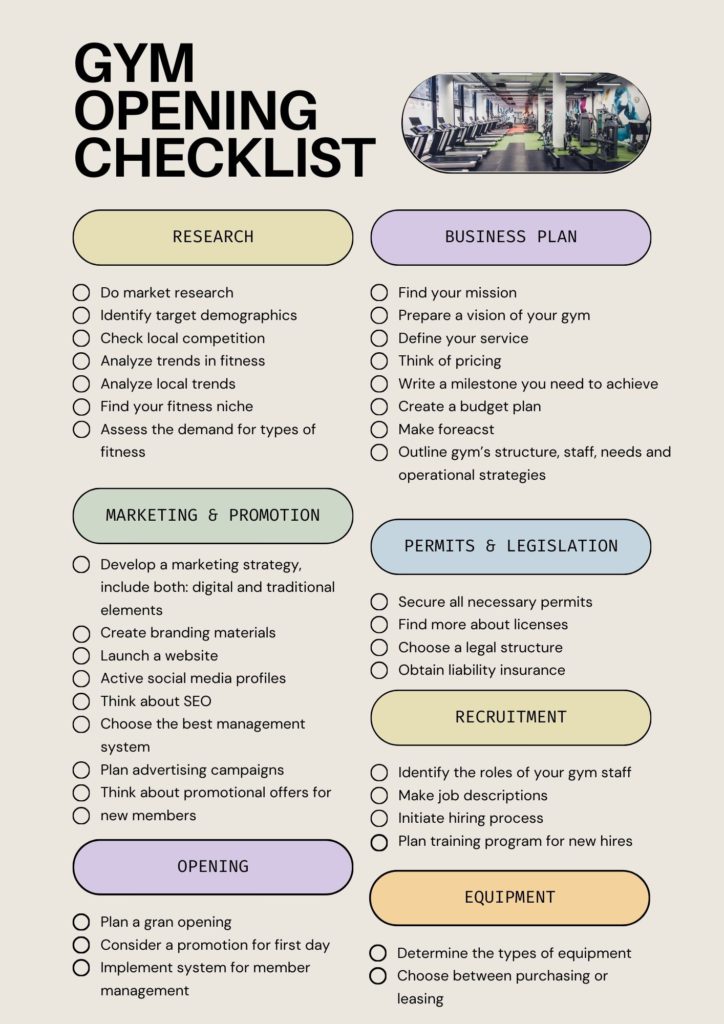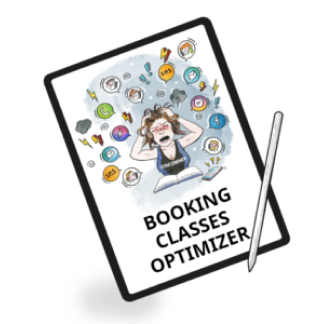Starting a gym business can be a rewarding endeavor, but it requires careful planning and execution. Wondering how to open a gym in 2024? It may not seem so simple, but with a list of things you need to know at hand, opening a gym will become less scary.
Growing awareness of the importance of health and wellness is likely to continue to drive demand for fitness services. No surprise if you’re thinking about opening your own gym.
But you need to remember that starting your own business requires a little more than a love of sports and healthy living. You need to know something more. Also you might wonder how to start a gym from scratch or what do you need to open a gym.
That’s why we’ve put together a guide that will tell you how to open a gym, what you need to know about legislative issues, what gym management software to choose and what other steps to take to open a gym.
How to start an own gym business?
Starting a gym business requires meticulous planning, significant initial investment and a clear understanding of the market. The first step to starting a gym is to develop a comprehensive gym business plan that outlines the vision, target market, competitive analysis and financial projections.
You need to pay attention to a number of factors at the outset. You think of how much does it cost to open a gym? The cost of opening a gym can vary greatly depending on the location (including the state in which you plan to open the gym and even the specific city, e.g. in Los Angeles the opening cost may be more than in San Francisco, which is also in California), size and equipment requirements. Initial expenses can range from US$10,000 for basic premises rental and equipment to over US$50,000 (and much, much more) for a fully equipped facility.

Research by the Health & Fitness Association (IHRSA) suggests that successful gyms are those that offer unique services, maintain quality equipment and create a strong community among gym members. Owning a gym also requires compliance with health and safety regulations, obtaining the necessary permits and investing in liability insurance.
What else do you need to keep in mind when opening a gym or fitness center? Effective marketing strategies and a strong online presence are key to attracting and retaining members. When considering how to open your own gym, focus on creating a welcoming environment that meets the fitness goals of your target demographic.
According to analyses of the fitness industry, diversifying revenue streams through personal training services, group classes and merchandise sales can significantly increase revenue. In summary, setting up a gym requires careful planning, significant financial investment and a strategic approach to stand out in a competitive market.
How to open a gym? There are 12 steps you need to follow to achieve a full successful dym. Ready to get started?
Step 1: Do market research and find your concept
We are not at all surprised that you are thinking about opening your own gym. The latest Global Wellness Institute (GWI) report shows that the wellness industry has grown by 64% over the last 10 years. It found that the industry is worth $5.6 trillion in 2022.
According to Bloomberg, the industry will grow even more by 2027. It is therefore the best time to get started.
Opening a gym or fitness center starts with a crucial first step: conducting thorough market research and defining a unique concept for your gym. This basic phase prepares the ground for the success of the venture.
By meticulously conducting market research and finding your unique concept, you create a solid foundation for your business. Understanding local trends, finding your niche, checking out the competition and identifying your target audience are essential steps in creating a gym that meets the needs of the community and stands out from the competition.

Analysis of local trends
To understand local fitness trends, start by reviewing industry reports and local health data, but also your competitors. Platforms such as Google Trends and social media can offer insight into what fitness activities are gaining popularity in your area.
Attend local fitness events or visit nearby gyms to learn about emerging trends and customer preferences. This research will help you assess demand for specific fitness services and identify potential gaps in the market.
Finding a niche for your gym
Identifying a niche is essential to differentiate your gym from the competition. Look for underserved markets in the fitness industry in your area. This could be boutique HIIT studios, yoga for seniors or gyms that offer cutting-edge fitness technology.
Your gym niche should align with your passions and experience, ensuring authenticity and long-term commitment. Analyzing customer feedback on existing fitness business offerings via online reviews and social media can also provide valuable information on unmet needs.
To stand out in the competitive fitness industry, you need to create a gym experience that members will love and remember. Examples of niches / types of gym:
- Boutique gyms: these are small facilities that offer an exclusive workout experience. They usually have a homely, friendly atmosphere and high-quality equipment. Boutique gyms also often offer special group classes such as cycling, HIIT training or functional training.
- Gyms with personal trainers: these are facilities that provide the services of professional personal trainers. Personal trainers work with clients on an individual basis, creating personalized training programmes, sometimes assisting with dietary programmes, offering support and motivation during workouts.
- Big box gyms: these are large gyms and fitness clubs, such as Planet Fitness, which operate on a franchise basis. They offer a wide range of weight training and cardio equipment, as well as group classes and other services such as a sauna or swimming pool. These gyms are frequently affordable and have multiple locations across the US.
- Gyms with 24/7 access: these are facilities that allow you to workout at any time of the day or night. They are particularly attractive for those with non-standard working hours or for those who prefer to train in the evening or early morning.
- CrossFit gyms: these are facilities dedicated to CrossFit training, which combines elements of strength training, cardio and gymnastics. CrossFit gyms offer intensive group classes, led by qualified coaches who motivate and support participants during the workout. Want to run this type of gym? Invest in CrossFit Management Software!
- Women’s gyms: these are facilities that provide a comfortable and safe workout space exclusively for women. They usually have specially designed equipment and offer a variety of classes that are geared towards women’s needs, such as strength training, Pilates classes or yoga.
- All-in-one gyms: are facilities that offer a comprehensive workout experience, combining elements of a traditional gym, personal training and other services such as saunas or swimming pools. Group classes are quite typical for universal gyms, so if you want to start one, get prepared and download a small group training program template.
- Fitness studios: are facilities that specialize in a variety of group classes such as cycling, pole dance, aerobics or other types of dance. They are known for their intense and effective workouts, led by qualified instructors.
- Yoga and pilates studios: these are facilities that specialize in this type of class. They offer a variety of yoga and pilates styles, from relaxing and restorative to intense and challenging. Instructors help participants improve strength, flexibility and balance of the body and mind.
Checking out the competition
Competitor assessment involves more than just identifying other gyms in your area. Visit them as a customer to understand their strengths and weaknesses, pricing models, services offered and customer experience.
Pay attention to their marketing strategies and community outreach efforts. This information will help you identify opportunities to differentiate and improve existing concepts.
Identifying the target group
The target group is the specific demographic group you want to serve, defined by factors such as age, fitness level, interests and goals. Use the insights gained from analyzing local gym trends and finding your niche to identify who your ideal members are.
Creating personas can be a helpful tool in understanding their motivations, challenges and what they are looking for in a gym. Surveys, focus groups and interviews with people in your target demographic can provide in-depth insight into their preferences and expectations.
Step 2: Prepare a gym business plan
A good gym business plan should be a solid foundation. It will help you define your business model, but also your needs. It is worth remembering that the business plan does not have to be permanent; you can modify it every time your gym will grow or change.

Opening a gym requires careful planning and strategic thinking from the very beginning of business creation. A key step in this process is to develop a detailed business plan that lays the foundations for the success of your gym. This plan should include:
- a mission and vision for the gym,
- clearly define your service offering and pricing,
- milestones you need to achieve,
- specific targets and completion dates,
- an accurate budget with revenue and cost projections.
Prepare a definition of your gym’s mission and vision statement
Your gym mission statement should concisely define the main purpose of your business and what you want to achieve in the fitness industry. It is about defining the problem you are solving for your clients and the unique approach you are taking. For example, your business mission statement might focus on promoting holistic wellbeing through innovative fitness solutions.
This doesn’t have to be difficult – perhaps your mission is to promote health, or maybe it’s a matter of you being an expert in a certain field or a trainer with years of experience. Use this to define what you will be about.
On the other hand, the vision statement should reflect how you see your gym in the future. It is an aspirational description of what you hope to achieve in the long term, such as becoming the leading fitness provider in your community or setting new standards in personal training services.
Identify why your gym will differentiate itself on price
Defining your service offering includes outlining the types of fitness programmes, classes and facilities your gym will offer. Will you specialize in personal training, group fitness classes, wellness programmes or a combination of these services? Consider the unique aspects of your services that will set you apart from the competition.
Pricing strategy is equally important and should be determined after thorough market research. Analyze what your competitors are charging and how much your target market is willing to pay. Prices can be structured in a variety of ways, such as membership fees, class payments or premium packages that offer additional services.
Remember that your prices should reflect the value of your offering, while still being competitive and accessible to your target demographic.
Create a budget plan and forecast so you know where you stand
A realistic budget is fundamental to a gym’s financial health. Start by estimating your start-up costs, which include rent or purchase of space, equipment, initial marketing and pre-opening operational expenses. Ongoing expenses such as staff salaries, utilities, maintenance, and marketing should also be meticulously planned.
Forecasting revenue requires an estimate of how much money the gym will make from its services. Factors such as membership growth, seasonality and potential expansion of services should be taken into account. It is prudent to prepare for a range of scenarios, including conservative estimates, to ensure financial resilience.
Finally, the business plan should include a break-even analysis to understand when the gym is likely to become profitable. This includes calculating the point at which total revenue equals total expenditure, providing a clear financial target to aim for.
By thoughtfully defining your gym’s mission and vision, carefully developing your service offering and pricing, and meticulously budgeting, forecasting revenue and costs, you will have a solid business plan to guide your gym to success. Why is this so important? Because according to research, only a third of small businesses – including gyms – will last more than 10 years.
Make realistic targets – develop your business goals
When starting a gym business, setting clear and achievable goals is essential for guiding your efforts and measuring success.
- Membership Growth: is crucial to a gym’s ongoing success, as it means a greater flow of clients and more revenue. Increasing membership numbers can come from an effective marketing strategy, offering attractive promotions, organizing community events and providing high quality service and equipment at the gym.
- Revenue Generation: is the primary goal of any operating gym. To be financially successful, a gym owner needs to identify various revenue streams, such as membership fees, retail sales, personal training services, renting advertising space or organizing additional classes and events.
- Customer Satisfaction: is important for maintaining the gym’s customer loyalty and attracting new customers. Satisfied customers often recommend the gym to their friends, which can contribute to membership growth. Therefore, it is important to ensure quality service, cleanliness and safety at the gym, as well as creating a friendly and helpful atmosphere. Looking for a way to increase gym member satisfaction? Invest in gym membership management software.
- Brand Awareness: plays a significant role in attracting new customers and building loyalty among existing members. The gym owner should invest in marketing strategies such as online and offline advertising, participation in local community events, and promoting positive customer feedback on social media.
- Member Engagement: is a key factor in maintaining customer loyalty and motivating them to train regularly. A gym can promote engagement by organizing competitions, fitness challenges, motivational programmes or regular meetings with healthy lifestyle specialists.
- Staff Development: is influential to ensure a high quality service and to continuously improve the gym. Investing in staff training and professional development can help to increase customer satisfaction, improve efficiency and build a strong employer brand.
- Additional Purchase: Try to anticipate a time when you will have enough money to expand your existing boxing equipment list, yoga studio equipment list, pole equipment list, etc. New or additional equipment will make your space more attractive.
- Retention Rate: or the percentage of customers who regularly use a gym’s services over an extended period of time, is an important measure of a gym’s success. A high retention rate demonstrates customer satisfaction and the effectiveness of loyalty retention strategies such as loyalty programs, regular analysis of customer feedback and tailoring the offer to customers’ needs.
- Fitness Consultant: You may also think of hiring a fitness consultant who is a mix of industry expert, marketer, and strategist — someone who understands fitness trends, knows how to engage audiences, and can align affiliate efforts with your brand’s bigger goals. This kind of support can help you optimize your program structure, choose the right partners, and build a more impactful presence in the fitness space.
Step 3: Legislation and permits you need to know
You want to open your gym – you have your business plan ready and you know what type of gym to choose. Now it’s your turn to get training and accreditations. First and foremost, it is important to:
- familiarize yourself with the local regulations for opening a gym in your state,
- obtaining the necessary permits and business license,
- choosing the right gym legal structure,
- think about professional liability insurance,
- be prepared for unexpected expenses.
When starting your own gym, choosing the right legal structure is a pivotal decision that can impact your business operations, tax obligations, and personal liability. Three popular options are Sole proprietorship, Limited Liability Company (LLC), and Corporation. Each structure offers distinct advantages and drawbacks.
Let’s delve into the specifics to help you make an informed choice.

Option 1: Sole proprietorship
Pros:
- Simplicity: a sole proprietorship is the simplest and least costly form of business structure. It requires fewer forms, lower initial fees and less red tape.
- Control: As the sole owner, you have full control over all decisions related to your gym.
- Tax benefits: Profits are taxed once as they are considered the owner’s personal income, avoiding the double taxation that corporations face.
Cons:
- Personal liability: The owner is personally liable for all business debts and liabilities. This risk extends to personal assets that can be used to satisfy business debts and court judgments.
- Funding limitations: Raising capital can be more difficult as shares cannot be sold and lenders may view a sole proprietorship as a riskier investment.
Option 2: Limited liability company (LLC)
Pros:
- Limited liability: owners (members) have liability limited to the amount invested in the LLC. Personal assets are usually protected from business debts and lawsuits.
- Tax flexibility: LLCs can choose to be taxed as a sole proprietorship, partnership or corporation, providing flexibility to optimize tax liabilities.
- Credibility: Forming an LLC can increase a gym’s credibility with potential clients and partners.
Cons:
- Complexity and costs: Setting up an LLC involves more paperwork and higher initial costs than a sole proprietorship. Ongoing requirements, such as annual reports, can add to the administrative burden.
- Differing state laws: LLC laws can vary widely from state to state, potentially complicating interstate business operations.
Option 3: Corporation
Pros:
- Limited liability: Shareholders’ personal assets are protected from corporate debts and liabilities.
- Capital raising: Corporations can raise funds by selling shares, potentially facilitating expansion and growth.
- Perpetuity: Corporations can continue to exist even if ownership or management changes, providing stability and continuity.
Cons:
- Regulatory and tax burdens: Corporations are subject to significant regulatory scrutiny and complex tax rules. They are subject to double taxation, where profits are taxed at the corporate level and again as shareholder dividends.
- Complexity: incorporation requires more paperwork, higher costs and ongoing compliance with corporate governance standards and reporting requirements.

Choosing the right legal structure for a gym requires balancing the level of risk you want to take, the complexity and costs you are prepared to manage, and how you plan to grow your business. Consultation with legal and financial specialists can provide personalized insights tailored to your specific situation and objectives, helping to ensure that your gym’s foundations are as strong as your clients aspire.
Practically every business in the US needs some kind of license to operate. In most cases, the federal government does not require a license to set up a gym. Check one with the US Small Business Bureau to see if your type of business is not regulated by the agency.
Remember that requirements may vary from state to state or local government to local government. What permits may be required to set up a gym?
- A child care license if you plan to provide a play area for the little ones while the adults are exercising.
- A food and retail license – especially if you want to sell goods that are taxable. You must have a valid business EIN and declare what you want to sell.
- Permits and licenses if you are running a spa or massage center – here again, depending on your state, you may be required to have the necessary license to run this type of service.
- License to run health services – if you want to run dietetic or physiotherapy services, you will also be required to have the relevant certificates and licenses. You can check whether your gym will be subject to HIPAA (the Health Insurance Portability and Accountability Act of 1996).
- License to have a swimming pool on the gym premises – for some states it is necessary to have a license for swimming pools and sometimes even showers. So check the state, county or city regulations in your area.
- CrossFit name using – you may not use the CrossFit name in any other business or promotional manner unless you are a member of the association. Only membership gives you the right to use the CrossFit name for business and/or promotional purposes.
Step 4: Find best location
The place where your gym will be located is one of the most important factors affecting your success. The right location is the key to attracting customers. The location of your gym must depend on a clique of factors.

What do you need to know about your gym’s location to beat your competition while still being able to attract new members?
- Understand your target market – based on this, you can select a location that will best meet the needs of your customer group. If you enter one of the fittest cities in America, can you still be competitive?
- Evaluate accessibility and ease of access to the gym – check whether the location you have chosen is accessible to everyone; pay attention to issues such as distance from bus or subway stops, access to ample parking, etc.
- See if there is competition nearby – evaluate whether the place where you want to open a gym is highly competitive; finding a location with few competitors may satisfy untapped demand in the area.
- See what the surrounding area is like – check whether there are single-family houses nearby, or maybe it’s a city center. Surroundings, including stores, their attractiveness matter. People who work in an office will find it easier to drop by a nearby gym than drive to a big box at the end of town.
- Consider the size of the building – keep in mind that the room in which your gym will be built must have space for equipment, locker rooms or exercise rooms. You also need to consider the growth of the gym, or the possibility of expanding the premises.
- Analyze the cost and terms of renting the premises – if you intend to rent, check the conditions you need to meet. Compare costs, check business projections. Also consider whether there are any hidden costs in the premises rental agreement.
- Check local regulations – this is very important! Before choosing a location, make sure it complies with local regulations for running a gym. Some locations may have restrictions on signage, parking or noise levels, which could affect the running of your gym.
Step 5: Gym financing strategies and sources
Congratulations, you have just moved on to the next step when opening your own gym. One thing is for sure – you need sources of funding to make your dream a reality. After all, it’s impossible to open a well-functioning business gym with no money.
The first step is to identify potential funding sources. It’s good to have your own savings – they can be a starting point, but sometimes it’s not enough and won’t be enough. Then you can bet on:
- Crowdfunding platforms also offer a way to raise funds while building a community of supporters.
- Finding an investor or business partner who shares your passion for fitness and wellness can provide the necessary financial boost and additional expertise.
- Opening a gym on a gym franchise basis, which involves partnering with an existing brand that offers you its naming rights, full business know-how and support, in exchange for a new gym franchise fee.
- Taking a business loan to open a new gym or a fitness studio.
- Small Business Administration (SBA) Loans.
You also need to estimate the cost of opening and running the business, so that you have a clear idea of how much you need to pay. When estimating costs of opening your gym, you need to take into account business expenses like:
- renting or buying a gym or just its future location,
- the cost of acquiring equipment,
- employment of personnel,
- management and marketing,
- ongoing operating expenses,
- equipment maintenance,
- legal fees,
- spa facilities,
- general liability insurance,
- worker’s compensation insurance.
Developing attractive membership options and competitive pricing structures is critical not only to attract members, but also to ensure a steady revenue stream. Consider offering a variety of membership packages to meet different needs and preferences, such as:
- one-time memberships,
- subscription memberships with month-to-month payments,
- annual contracts,
- premium packages that include personal training and other services.
This approach can maximize revenue potential and provide greater predictability of cash flow, which is attractive to lenders and investors.
What should you keep in mind when opening your gym? Financing methods:
- Bootstrapping: using personal savings to fund your gym is the simplest form of financing, avoiding debt or equity arrangements.
- Family and friends: borrowing from family and friends can be a flexible and accessible option. However, it’s essential to treat it as a formal business arrangement, with clear terms and expectations to avoid personal and financial misunderstandings.
- Small Business Loans: loans are popular due to their relatively low interest rates and structured repayment plans. They require a solid business plan and good credit but can provide substantial funding.
- Equipment Financing: this method allows you to spread the cost of equipment over its useful life, preserving cash flow for other operational needs.
- Lease: leasing your gym space and even equipment can reduce initial capital requirements. Although it might increase long-term costs, leasing offers flexibility and reduces upfront investments.
- Crowdfunding: Platforms like Kickstarter or Indiegogo can provide a way to raise funds while building a community around your gym.
- Angel Investors or Venture Capital: If your gym concept is particularly innovative or has high growth potential, securing investment from angel investors or venture capitalists could be a viable option. This route usually requires giving up a stake in your business and potentially some level of control.
- Government Grants and Subsidies: Exploring fitness grants and subsidies available for small businesses, especially those promoting health and wellness, can provide a non-repayable funding source.
Step 6: Gym marketing and promotion
When you are opening a gym in 2024, you need to take care of another important issue – marketing and promotion. These are also vital for attracting members and building a competitive position. By taking gym marketing seriously, you can reach a variety of customers through multiple channels.
Gym marketing software will help you gain publicity, so never wait until the last minute! It’s well known that you have a lot on your mind when opening your business, but this one is also essential and shouldn’t be overlooked. Let people hear about you and they will come to see what your gym has to offer.
Focus on the four small steps that will get your gym’s marketing off on a high note.

Develop a marketing strategy
Create a gym marketing strategy that identifies:
- the target market you want to reach with your gym offer (you already had this developed when you created your business plan, so one point out of the way),
- the marketing objectives you want to achieve (at first, bet on reach and recognition in general, so that people find out about your gym),
- the channels you want to use (this doesn’t immediately have to be a big investment or presence in all media).
Set clear goals for your gym’s marketing strategy that are measurable, such as attracting new members, increasing registrations for a particular class, or better awareness among the local community.
Build your gym branding and corporate identity
Another important consideration when it comes to marketing your gym is creating a strong brand and identity – this will help you stand out in the marketplace.
Your brand should reflect the ethos and values of your gym. This is important whether you focus on, for example:
- supporting all exercisers,
- focusing on high-intensity training,
- specializing in wellness and recovery,
- weight loss training and classes.
When building your brand, but also when creating marketing materials, always emphasize what your gym represents. Show what sets it apart, so you can show customers what makes you different.
Invest in advertising and promotion
It is very significant to maximize your reach to potential customers. So combine advertising campaigns – and both online and offline. You can use traditional methods, such as advertising on local radio or in newspapers, or you can rely on online promotion.
Combining these with online advertising – such as targeted Google Ads campaigns, website SEO optimisation and email marketing – can increase your reach and allow for more precise targeting and analysis.
A good promotional idea? Offer new members a bonus for visiting the gym on the first day it opens or for a longer period. Offer a bonus for the first purchase of a pass, or a discount or even a free personal training session. This will encourage people to use the gym more effectively than any advertising and can bring huge benefits.
Do you know what else will be useful? A website to showcase your class schedule, your gym’s offerings or show who the staff are. Plug in the right gym management system like WodGuru and you’ve got a sure-fire success on your hands.

Did you know that up to 97% of users first search for local businesses on the Internet? Statistics show, therefore, that it is worthwhile for your business to show up on both your website and Google Maps.
Take advantage of SoMe and influencers
Social media is invaluable in promoting a gym, offering a direct channel to engage current and potential members. Sharing quality content, including workout tips, success stories and live class previews, can increase engagement.
What else can you do? Collaborating with fitness influencers and local celebrities can also increase reach, boosting credibility and tapping into their follower base.
Step 7: Recruitment of personnel – find the best trainers
Opening a gym also involves hiring staff. Without them, as well as without equipment – it is impossible to run such a place! So what do you need to keep in mind?
- As a business owner you need to start by identifying positions and needs – work out what competencies are needed in your gym.
- Develop a robust recruitment process to select the best.
- Use job adverts on fitness industry websites, social media and professional networking sites to reach a wide audience
- Check competencies, especially if you are hiring personal trainers or class leaders.

Hiring process is one thing – proper training is just as important. Train your staff, invest in their education, and it will pay off! By doing so, you will ensure your clients have the best experience working with your gym.
Finding the best trainers requires not only assessing qualifications and experience, but also making sure they are in line with your gym’s culture and values. Through a meticulous recruitment and selection process and ongoing training and development, you can build a team of professionals who will contribute to a positive and motivating atmosphere at your gym, attracting and retaining members.
Step 8: Gym decor and equipment – create the right interior
The time has come to look after the fitness equipment in your gym to ensure high quality fitness experience. So you need to focus on which machines and equipment will best suit your clients’ needs. The basics are one – the equipment in your gym must never be of low quality!
There are a few things you need to keep in mind when choosing equipment:
- Determine which equipment will be essential in your gym.
- Plan the cost of both the expensive equipment, such as a treadmill, push sled or weights, and the extras – a bike, orbiters, or medicine balls.
- Decide what you really need – some equipment can be bought over time.
- Match the equipment to the size of your gym – it’s important not to clutter up the space.
- Consider whether it’s better to buy equipment or hire it.

What equipment should you invest in? That’s what depends on your customers and what your gym offers.
- Versatile machines – these will be useful at most gyms, providing access to both cardio and strength training.
- Stretching – stretching machines provide good preparation before many workouts, but can also be used in boutique gyms.
- Bodybuilding – if your gym is going in this direction, invest primarily in barbells, heavy machines or body sculpting equipment.
- Functional training rooms – specialist equipment will be needed here, depending on the type of training; different needs will be for a cross fit or boxing room, and different for a Pilates or yoga studio.
Effective space design is key to maximizing the usability and flow of a gym. The aesthetics of the gym should reflect the brand and appeal to the target audience, creating an inspiring and motivating atmosphere.
The interior of a gym plays a significant role in the overall customer experience. Careful consideration of space design, equipment selection and the balance between aesthetics and functionality can create an environment that not only meets members’ practical needs, but also inspires and motivates them to achieve their fitness goals.
Step 9: Use gym management software
At this step, it’s time to think about managing your members and running your gym efficiently. You already have a website, you’re conducting promotional activities, you’re getting ready to open – it’s time to invest in gym or fitness studio management software.
The best choice on the market? WodGuru, which is a professional gym management software that will allow you to streamline the work and management of your gym. With it you can in a very intuitive and simple way, among other things:
- register new members,
- conduct registration for club classes,
- share the schedule of your gym,
- check the activity of your gym customers thanks to gym membership management software,
- automate daily work and tasks,
- improve marketing,
- use it as gym check-in system,
- try WodGuru as gym CRM,
- take care of and monitor payments.
One tool, and it will provide so many options! In addition, we compared how WodGuru compares with 15. other best gym management software. Frankly speaking, it’s hard to find an equally effective and affordable solution to streamline the entire gym management process.
What else do you need to know about WodGuru? This is a system that is very attractively priced – up to 10 members you pay nothing. After that, the price is $1 per member, of which the maximum amount you will incur is $119.

This is a new player on the American market, but thriving in Europe. Remember, you can test this solution for as long as you want – and without obligation. So why shouldn’t you give it a try?
Step 10: Opening and first steps of being a TRUE gym owner
It’s a great time to be a gym owner – it’s that moment when you can think about your opening and planned promotion. Start by creating a buzz with pre-opening events, offering special membership discounts and engaging the local community through fitness challenges or health workshops. This not only attracts first-time customers, but also builds anticipation and interest in the offer.
Once the doors have opened, providing quality customer service becomes paramount. Every member should feel valued and supported, from personalized fitness plans to mechanisms for responding to feedback. Staff should be well-trained not only in the fitness aspects, but also in creating a welcoming and motivating environment.
By focusing on these key measures, you can ensure that your gym grand opening is not only a celebration, but also a strategic launch that prepares your business for continued engagement and growth.

What to remember at your gym’s grand opening? Most gym owners need to think about:
- Plan an official opening, even with a ribbon cutting, to mark it as your first day of operation
- Hold an open day – during this, everyone will be able to visit the gyms, find out about what’s available in your fitness brand
- Offer free classes on the first day – this can give potential members a foretaste of what to expect when they join the gym
- Offer promotions and discounts on passes – this could include discounts on membership, free extra months after signing an annual contract or special rates for group classes
- Schedule live demonstrations of popular or unique fitness classes to showcase your trainers’ expertise and the variety of programmes available
- Create interactive fitness challenges or friendly competitions among participants with prizes or gym merchandise as prizes.
- Partner with local businesses such as health food cafés, sports shops or wellness centers to sponsor the event or provide giveaways
- Intensively promote the event on social media platforms before the grand opening
Step 11: Focus on providing a positive gym experience
The dynamic nature of the fitness industry requires you to constantly monitor and adapt your strategy to market response. Keep a close eye on member engagement, market trends and customer feedback. This data-driven approach allows you to improve your offering, marketing strategies and operational processes.

Your gym will require development and observation, but that’s a good thing! This will ensure that you don’t settle on your laurels and that you offer the best to people. Be prepared for both the good times and the harder times.
Remember that you can always modify your business plan, take care of elements for improvement or invest in more equipment or activities. If something you originally set out to do doesn’t work out – don’t give up hope!
Step 12: Maintaining success and further development
The last, but arguably also the most difficult step is now before you – maintaining your success and continually developing your gym. It’s all in your hands now, and it’s time to make sure you’re committed and regularly evaluate your results.

You can conduct customer satisfaction surveys, check profitability and finances using WodGuru, or conduct marketing activities, also through this tool. This data-driven approach allows you to make informed decisions about where improvements are needed or where new opportunities lie.
Additionally, brand development and service expansion are key growth strategies. This may include broadening the gym’s appeal to a wider audience or specializing in niche markets such as rehabilitation programmes or training for elite athletes.
Expanding services can also include partnerships with health professionals, cafe’s and wellness centers to offer a more comprehensive health and fitness package. By focusing on these strategies, gyms can not only maintain their current success, but also grow and thrive in a competitive market.
Final thoughts
- Conduct market research to understand the demand for a gym in your area, target demographics, and competition.
- Define your unique selling proposition (USP) â what will set your gym apart from others?
- Create a detailed business plan outlining your goals, target market, services offered, budget, and marketing strategy.
- Choose a suitable legal structure for your business (sole proprietorship, partnership, LLC, etc.).
- Find a suitable location with good visibility, ample parking, and easy accessibility for your target market.
- Purchase high-quality gym equipment based on the types of workouts you’ll offer (cardio machines, strength training equipment, free weights, etc.).
- Hire qualified fitness trainers, instructors, and front desk staff who are knowledgeable, friendly, and customer-oriented.
- If you know someone who has a predisposition to the profession but does not yet have the appropriate documents, encourage them, tell them how to become a fitness instructor and promise them employment.
- Develop membership packages and pricing plans that cater to different needs and budgets.
- Create a marketing plan to promote your gym through various channels such as social media, local advertising, website, and community events.
- Host a grand opening event to generate buzz and attract potential members.
- Focus on providing exceptional customer service and a positive gym experience to retain members.
- Regularly review your business performance, financials, and member satisfaction levels.

FAQ
How much does it cost to open a gym?
Opening a gym in 2024 is a great idea, but how much would it cost to open a gym? Expenses can vary greatly and depend on issues such as:
- the type of gym
- the size of
- type of equipment
- the number of staff employed
- location
- level of adaptation
Home gyms are the cheapest, costing between $5,000 and $5,000,000. Much more will be involved in setting up a large facility in a good, prestigious location. Here, the cost of opening a gym can be over $500,000.
You can find out more in our post: “How much does it cost to open a gym in 2024?”
How profitable is owning a gym?
Is it profitable to open a gym? Yes, opening a gym can be profitable.
However, profitability depends on several factors including location, gym size, membership fees, and the range of services offered. Effective management and innovative service offerings can enhance profitability, but it’s important to manage initial investments and ongoing operational costs carefully.
Most gyms see profitability within the first one to three years of operation, depending on their ability to control startup costs, manage operations efficiently, and grow their member base. Proper financial planning and a strong marketing strategy are crucial for achieving profitability sooner.
How hard is it to open a gym?
Is it hard to open your own gym? Opening a gym can be a challenging endeavor, but with thorough planning and dedication, it can also be quite rewarding. You have to remember about:
- capital investment – the initial financial outlay to open a gym is substantial
- finding the right location – the success of a gym often depends significantly on its location. The ideal location is accessible, visible, and situated in an area with a demographic that matches your target market
- compliance with regulations – gyms must adhere to a variety of regulations, including health and safety standards, zoning laws, and sometimes specific fitness industry accreditation
- membership acquisition and retention – retaining members can be even more challenging, requiring continuous engagement and adapting to changing fitness trends and client expectations
- staff recruitment and management
- maintaining equipment and facilities
- adapting to industry trends
Opening a gym involves overcoming these challenges through strategic planning, market analysis, solid financial management, and a commitment to quality service. While it is a significant undertaking, the reward of creating a thriving community hub for fitness can be immensely fulfilling.
How to open a gym in a small town?
Exactly the same as in the big city! You need to keep the identical assumptions in mind, follow the steps we have given you and you are done.
The only difference is that you need to research your target group more thoroughly (whether there is a demand for another, or maybe the first, fitness club in your city). Also check out the competition and decide what you can be better at than them with your gym.
How to open a gym with no money?
Opening a gym with no money presents unique challenges, but with creativity and strategic partnerships, it’s possible to launch that gym business.
Start by exploring partnership opportunities with existing facilities, such as schools, community centers, where you can use their space during off-hours in exchange for a revenue share or a minimal fee.
You can also think about gym startup costs and then consider crowdfunding to raise initial capital, highlighting your gym’s community benefits and unique approach to fitness to attract potential backers. Leveraging social media platforms can also provide a low-cost way to build a following and market your services. Offering outdoor boot camps or personal training sessions in public parks can generate initial revenue without the overhead costs of a physical location.
As you build a client base and reputation, you can explore more traditional financing options or reinvest profits to gradually expand into a dedicated space. This approach allows you to start a gym with minimal initial investment, focusing on building a strong foundation before scaling up operations.
Relation articles
How Do Gyms Make Money? (20 Ways Gyms Make Money in 2024)
How to Write a Gym Business Plan (Step-by-Step Guide + Free Template + Examples)
20 Types of Gyms (Guide for Gym Owner With Examples)
How Much Do Gym Owners Make in 2024
20 Fittest Cities & States in America to Choose Your Gym Location in 2024
300 Gym Slogans to Boost Your Brand in 2025
Creating a Gym with Childcare: 11 Tips for Success
8 Fitness Grants in 2025 (Use Grants for Fitness Businesses)
17 Gym Business Models (How to Choose the Best One)
Hiring & Managing Gym Staff: Gym Owner’s Guide in 2025
Gym for Seniors Only: Pros, Cons & 8 Tips for Success
How to Open a Gymnastics Gym in 15 Steps (Cost to Start)





